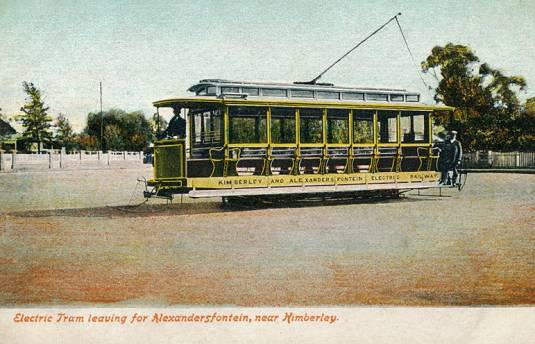

Kimberley is a town in the Northern Cape province of South Africa and synonymous with diamonds. The first two diamonds in the area were discovered in 1866 and 1869 but a much larger one was found in 1871 on a farm hillside owned by the De Beers brothers, a name associated with the world diamond trade to this day. This discovery precipitated the "New Rush" for diamonds which resulted in the huge Kimberley Mine (or 'Big Hole') being dug between 1871 and 1914. It had a workforce of up to 50,000 that dug, by hand, a hole nearly 250m deep and over 450m in diameter, under which mine shafts were sunk to a depth of over a kilometre.
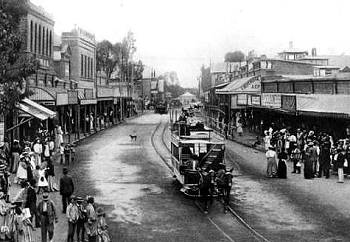 As early as 1873, Kimberley was the second largest town in South Africa with a population of around 40,000. In 1880, the Kimberley Tramways Company was formed but construction never started. Another company, the Victoria Tramways Company, was founded in 1886 and construction started soon thereafter. This was a narrow (3ft. 6in., 1067mm) gauge line between Kimberley and the nearby Borough of Beaconsfield. The cars were originally drawn by horses but later by mules, as seen in the c.1899 photograph of Du Toitspan Road, Kimberley (left).
As early as 1873, Kimberley was the second largest town in South Africa with a population of around 40,000. In 1880, the Kimberley Tramways Company was formed but construction never started. Another company, the Victoria Tramways Company, was founded in 1886 and construction started soon thereafter. This was a narrow (3ft. 6in., 1067mm) gauge line between Kimberley and the nearby Borough of Beaconsfield. The cars were originally drawn by horses but later by mules, as seen in the c.1899 photograph of Du Toitspan Road, Kimberley (left).
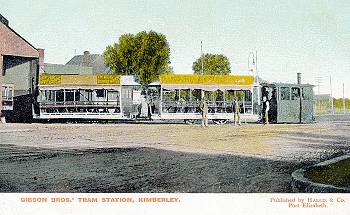 Later still, unsuccessful experiments were tried using battery power. From 1900, there was more success when second-hand (from England) steam-tram engines were used. The view (right) shows such a steam tram with two open sided trailers outside the depot, on a postcard published by Hallis & Co. of Port Elizabeth.
Later still, unsuccessful experiments were tried using battery power. From 1900, there was more success when second-hand (from England) steam-tram engines were used. The view (right) shows such a steam tram with two open sided trailers outside the depot, on a postcard published by Hallis & Co. of Port Elizabeth.
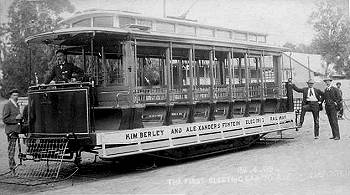 On the same gauge, a new six-mile long electric tramway opened on 25th April 1905 between Kimberley and Alexandersfontein (a more affluent area) operated by the De Beers Consolidated Mines Company. The tramway itself went under the title of the Kimberley & Alexandersfontein Electric Railway (KAER). The view (left) is from an unknown publisher and shows the first car on that route. The Beaconsfield route was converted to electric traction in 1906 and other routes and extensions followed. Rolling-stock details are rather sketchy but original trams were open-sided cross-bench cars mounted on 4-wheel trucks believed to have been supplied by Brill, although later deliveries may have had Peckham trucks.
On the same gauge, a new six-mile long electric tramway opened on 25th April 1905 between Kimberley and Alexandersfontein (a more affluent area) operated by the De Beers Consolidated Mines Company. The tramway itself went under the title of the Kimberley & Alexandersfontein Electric Railway (KAER). The view (left) is from an unknown publisher and shows the first car on that route. The Beaconsfield route was converted to electric traction in 1906 and other routes and extensions followed. Rolling-stock details are rather sketchy but original trams were open-sided cross-bench cars mounted on 4-wheel trucks believed to have been supplied by Brill, although later deliveries may have had Peckham trucks.
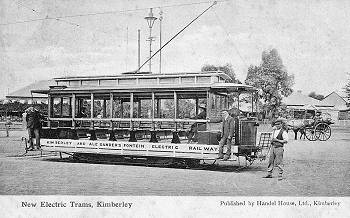 Our main title view shows one of the original electric cars, possibly car 1, at the Kimberley terminus about to leave for Alexandersfontein. The postcard is from an unknown publisher. Another image (right), shows the same or a similar car when new in 1905, with the postcard proudly entitled, "New Electric Trams, Kimberley". This was published by Handel House Ltd. of Kimberley and posted from the town to Falmouth in England in September 1907. The final view (below left) shows one of the early but larger bogie cars, number 3, probably at the Alexandersfontein end of the line, on a card published by Hallis & Co. of Port Elizabeth. This was posted from Kimberley Station to Ipswich in Suffolk, England, on December 18th 1906.
Our main title view shows one of the original electric cars, possibly car 1, at the Kimberley terminus about to leave for Alexandersfontein. The postcard is from an unknown publisher. Another image (right), shows the same or a similar car when new in 1905, with the postcard proudly entitled, "New Electric Trams, Kimberley". This was published by Handel House Ltd. of Kimberley and posted from the town to Falmouth in England in September 1907. The final view (below left) shows one of the early but larger bogie cars, number 3, probably at the Alexandersfontein end of the line, on a card published by Hallis & Co. of Port Elizabeth. This was posted from Kimberley Station to Ipswich in Suffolk, England, on December 18th 1906.
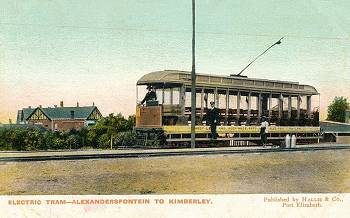 The tramways came under municipal ownership in 1914 but continued to be operated, as Kimberley Tramways, by the De Beers company under a leasing agreement. By 1939, only the route to Kenilworth remained and that closed in 1947. Part of the system remained in occasional use for De Beers employees and tourists until 1964. That might have been the end of the story but for a heritage tramway proposal of 1983 that came to fruition in 1985. Still using the original gauge but on new alignments, it ran from the City Hall to the Open Mine Museum close to the original Kimberley ('Big Hole') mine, a distance of nearly a mile. Restored original cross-bench tram 1 was used. Both the tramway and museum closed in 2005 for renovation but reopened at the end of 2006. Erosion made the 'Big Hole' even bigger, so much so that the nearby road had to be closed in 2008 and with it the tramway. It is doubtful if the tramway will ever run again.
The tramways came under municipal ownership in 1914 but continued to be operated, as Kimberley Tramways, by the De Beers company under a leasing agreement. By 1939, only the route to Kenilworth remained and that closed in 1947. Part of the system remained in occasional use for De Beers employees and tourists until 1964. That might have been the end of the story but for a heritage tramway proposal of 1983 that came to fruition in 1985. Still using the original gauge but on new alignments, it ran from the City Hall to the Open Mine Museum close to the original Kimberley ('Big Hole') mine, a distance of nearly a mile. Restored original cross-bench tram 1 was used. Both the tramway and museum closed in 2005 for renovation but reopened at the end of 2006. Erosion made the 'Big Hole' even bigger, so much so that the nearby road had to be closed in 2008 and with it the tramway. It is doubtful if the tramway will ever run again.
Several tramcars of this unusual line still exist in museums including one of the Dick, Kerr steam tram engines that came from England in 1899 although it was built in 1876. A bogie cross-bench car (no.33) of 1925 is in the transport museum at Johannesburg. Original cars 1 and 2 are still believed to be stored in Kimberley.
![]() Go to Postcard Of The Month Index
Go to Postcard Of The Month Index